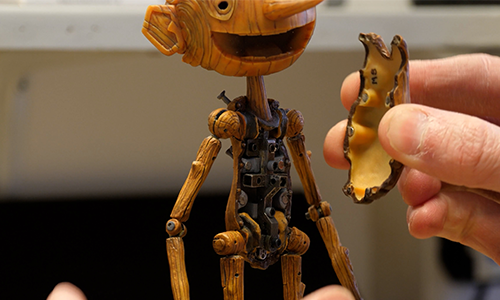Did you know that the stop-motion puppetry featured in Guillermo del Toro’s 2022 film Pinocchio was accomplished through the use of metal 3D printing? Our story begins in the year 2008, when del Toro envisioned a unique animated experience for his story. He reached out to Mackinnon & Saunders, a company well-known for their puppet designs. If you’ve ever seen The Corpse Bride, The Fantastic Mr. Fox, or Bob the Builder, you’ve seen their work in action.
Del Toro wanted to shift away from the conventional approach of employing countless casted puppet iterations. A single figure equipped with moveable joints would be much easier and more practical to film. Unfortunately, the kind of puppet the acclaimed director wanted was simply not possible to construct with the technology available at the time.
In 2020, 12 years later, everything changed. No, not those changes. Rather, additive manufacturing technology had advanced to the point that Guillermo’s vision could finally become a reality. For assistance, Mackinnon & Saunders contacted a longtime partner, Laser Prototypes Europe (LPE), a Northern Irish firm with decades of 3D printing experience for the film industry.
“Due to the fact that they were mechanizing the puppets and making them into essentially miniature robots, the requirement from the outset was for metals over plastics.” said Patrick Walls, engineering director at LPE. “That’s why we chose stainless steel, to ensure that the puppet wouldn’t deflect when it moved and there wouldn’t be a bending force.”
The teams collaborated on the design of a hollow-bodied puppet that would be fitted with internal mechanisms to enable the movement of its limbs. A crew of five was needed to remove supports, sand rough edges, and assemble the props. If you’ve used 3D printers for any amount of time, you’ve probably got a story about annoying supports marring the final quality of a print. Just imagine having to work out those kinks for something destined for the scrutinizing eyes of Hollywood audiences.
“We had to develop a protocol as to how they were hand finished to make sure that each of the team members was sanding and removing support structures in such a way as to avoid bringing up lines or marks. It was meticulous, slow and methodical, but we got there in the end!” explained Walls.
The Mlab metal printer from GE Additive played a crucial role in the project. Utilizing a100 watt laser, the Mlab was able to produce highly detailed, uniform, interlocking metallic pieces for the puppets. While GDT and the team at Mckinnon & Saunders were impressed with what the Mlab could produce, they still feared that it wouldn’t be able to capture the desired woodgrain effect for the outer shell of the puppet. Those fears were quickly put to bed.
McKinnon & Saunders and del Toro weren’t the only ones pleased with the outcome—so was the Academy of Motion Picture Arts and Sciences. Pinocchio won the Oscar for best animated film in 2023. While AM has been used for stop-motion films before, most notably by LAIKA, this was the first time that 3D printing enabled the creation of such a complex prop. Laser Prototypes Europe expressed pride in the collaboration with GE Additive, recognizing it as a step towards the future of cinema. It’s not just movie magic; it’s a glimpse into the intriguing possibilities of innovative technology in filmmaking.
Subscribe to Our Email Newsletter
Stay up-to-date on all the latest news from the 3D printing industry and receive information and offers from third party vendors.
You May Also Like
Model No. Deploys Titan Pellet 3D Printers for Sustainable Furniture Production
Over the years, many designers have tried to create 3D printed polymer furniture. Early pioneers like Janne Kyttanen, Materialise’s MGX, and Joris Laarman have led the way with 3D printed...
AddUp’s New Services Aim to Accelerate Metal 3D Printing Adoption
French laser powder bed fusion firm AddUp plans to use its Service Department to accelerate adoption. Recently, AddUp has shipped machines to Zeda, introduced its machines to Japan, and appointed...
3D Printing News Unpeeled: Recycling PLA, More Efficient Atomizing
Filamentive hopes to recycle your PLA if you’re in the UK and order over £500 worth of filament. Their partner 3D Printing Waste (3DPW) will turn the PLA into injection...
The Colossus of Constantine Reborn in Italy with the Help of 3D Printing
It’s amazing how quickly art can get lost to history. From pillaging to simple misplacements, there are countless examples of classic works vanishing in an instant. However, today, that doesn’t...


































